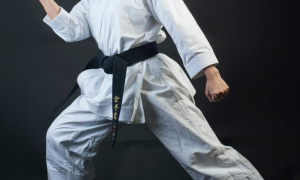
While traditional karate schools often adhere to the straightforward belt system, the landscape has evolved. Today, the emergence of karate belt stripes has become a common addition to many schools
Here at FamilyProz, we’ve already unveiled the intricacies of the conventional karate belt system, providing a comprehensive overview for all to appreciate. Yet, as torchbearers of martial arts knowledge, we’re excited to delve into the captivating realm of the stripped karate belt system. In this article, we’ll paint a vivid picture of the colors, order, meanings, and strategic placement of karate belt stripes. Get ready to journey beyond the traditional path and explore the captivating universe of stripped karate belts
Table of Contents
Toggle![]()
Karate Stripe Belt Order
In the absence of a standardized system, various schools have embraced stripped versions of karate belts. One of the most common approaches involves using the color of the next highest belt as a stripe on a practitioner current belt.

- White Belt
- Yellow Belt
- Yellow Belt with Orange Stripe
- Orange Belt
- Orange Belt with Green Stripe
- Green Belt
- Green Belt with Blue Stripe
- Blue Belt
- Blue Belt with Purple Stripe
- Purple Belt
- Purple Belt with Red Stripe
- Red Belt
- Red Belt with Brown Stripe
- Brown Belt
- Brown Belt with Black Stripe
- Black Belt
This approach essentially doubles the number of distinct belts, each with its unique combination of colors and stripes. As a whole Karate belt stripes carry several advantages and disadvantages.
Advantages of Karate Belt Stripes |
|---|
| – Enhanced Motivation: With more milestones to aim for, practitioners often find themselves consistently motivated to progress and achieve new stripes. |
| – Tangible Progress: Stripes provide tangible markers of improvement, offering a visual representation of a practitioner’s journey. |
| – Step-by-Step Growth: The progression becomes more incremental, allowing practitioners to focus on mastering skills at each level before advancing to the next. |
Disadvantages of Karate Belt Stripes |
|---|
| – Financial Implications: More frequent gradings and exams may be required for each stripe, potentially leading to increased costs for practitioners and their families. |
| – Time Investment: Regular testing and preparation for exams can demand a considerable amount of time and effort from practitioners. |
| – Distraction from Core Training: Excessive focus on belt stripes might shift attention away from fundamental training and skill development. |
Alternative variations of the same striped system are also prevalent. In these variations, the stripe’s color isn’t tied to the next highest belt; instead, it’s consistently either white or black. This approach doesn’t carry any additional symbolic significance but rather functions as a consistent halfway marker between the traditional solid-colored belts in many martial arts schools.
The White Striped Karate Belt Order is as follows:

- White Belt
- Yellow Belt
- Yellow Belt with White Stripe
- Orange Belt
- Orange Belt with White Stripe
- Green Belt
- Green Belt with White Stripe
- Blue Belt
- Blue Belt with White Stripe
- Purple Belt
- Purple Belt with White Stripe
- Red Belt
- Red Belt with White Stripe
- Brown Belt
- Brown Belt with White Stripe
- Black Belt
The Black Striped Karate Belt Order is as follows:

- White Belt
- Yellow Belt
- Yellow Belt with Black Stripe
- Orange Belt
- Orange Belt with Black Stripe
- Green Belt
- Green Belt with Black Stripe
- Blue Belt
- Blue Belt with Black Stripe
- Purple Belt
- Purple Belt with Black Stripe
- Red Belt
- Red Belt with Black Stripe
- Brown Belt
- Brown Belt with Black Stripe
- Black Belt
![]()
Comparing Karate Belt Stripes Orders
Belts in karate, regardless of their striped variations, serve as markers along a practitioner’s journey. Let’s take a closer look at how the classic karate belt system, karate colored stripes, and karate white/black stripes compare:
| Classic Karate Belt System | Karate Colored Stripes | Karate White/Black Stripes |
| White Belt | White Belt | White Belt |
| Yellow Belt | Yellow Belt | Yellow Belt |
| Yellow Belt with Orange Stripe | Yellow Belt with White/Black Stripe | |
| Orange Belt | Orange Belt | Orange Belt |
| Orange Belt with Green Stripe | Orange Belt with White/Black Stripe | |
| Green Belt | Green Belt | Green Belt |
| Green Belt with Blue Stripe | Green Belt with White/Black Stripe | |
| Blue Belt | Blue Belt | Blue Belt |
| Blue Belt with Purple Stripe | Blue Belt with White/Black Stripe | |
| Purple Belt | Purple Belt | Purple Belt |
| Purple Belt with Red Stripe | Purple Belt with White/Black Stripe | |
| Red Belt | Red Belt | Red Belt |
| Red Belt with Brown Stripe | Red Belt with White/Black Stripe | |
| Brown Belt | Brown Belt | Brown Belt |
| Brown Belt with Black Stripe | Brown Belt with White/Black Stripe | |
| Black Belt | Black Belt | Black Belt |
Karate belt stripes function as intermediate milestones between solid-colored belts. For instance, a purple-striped belt serves as a halfway point between a blue belt and a purple belt. Whether you’re progressing through the classic system, embracing the multicolored journey, or opting for the distinctive white/black stripes, each belt variation contributes to your growth and advancement in the world of martial arts.
![]()
Frequently Asked Questions About Karate Belt Stripes
![]()
Do Karate Belts Have Stripes?
Yes, some schools’ Karate belts do indeed have stripes. These stripes are often used to signify intermediate progress within each belt rank, adding an exciting layer of accomplishment and motivation to a practitioner’s journey.
How Many Stripes Are There in Karate?
The number of striped belts in karate can vary between different martial arts schools. Some schools might use a system with one or two striped belts per color, while others could implement more to represent different levels of advancement. With 1 stripe per belt color, expect that system to have around 16 belts total.
What Does a Blue Stripe Mean in Karate?
A stripe in karate indicates a halfway point between belts. It’s like hitting the midpoint of a journey, showing a practitioner is at least halfway through their progression from one belt color to the next. A blue stripe would usually be found on a green belt, signifying the practitioner’s progress from green to blue.
Where Do You Put the Stripes on a Karate Belt?
Karate belt stripes run through the center of the belt, resembling a filling in a sandwich. This placement adds visual interest and signifies a practitioner’s progress. It’s a badge of dedication and growth.
What Does a Black Belt with Red Stripe Mean in Karate?
it often signifies a master level belt. Typically introduced at the 4th dan Black Belt level, this distinctive belt acknowledges a practitioner’s elevated expertise and deep understanding of the art. However, the timing of this introduction may vary depending on the specific Karate organization.
![]()
Conclusion: Recognizing Karate Belt Stripes
Karate belt stripes stand as symbols of commitment and progress. Each stripe represents a step forward on the path of martial arts mastery. However, practitioners should be cautious of excessive stripes, which could lead to more grading expenses. Traditional karate teachings also hold value, emphasizing true learning over excessive symbolism. Ultimately, whether you choose stripes or adhere to tradition, your dedication to growth remains the core.


